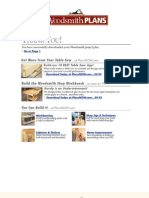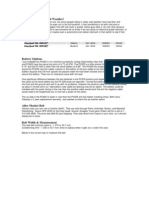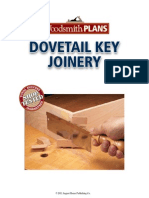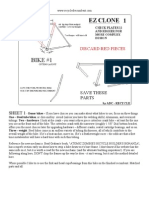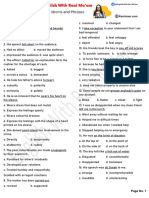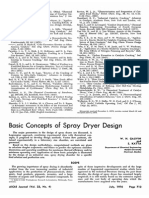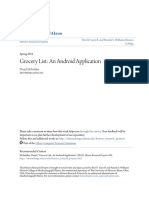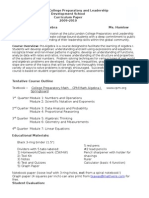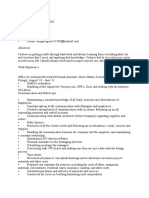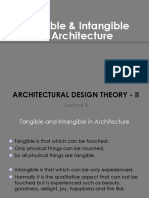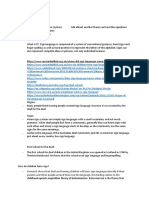Pinewood Derby Tips
Pinewood Derby Tips
Uploaded by
rjzepfelCopyright:
Available Formats
Pinewood Derby Tips
Pinewood Derby Tips
Uploaded by
rjzepfelOriginal Description:
Copyright
Available Formats
Share this document
Did you find this document useful?
Is this content inappropriate?
Copyright:
Available Formats
Pinewood Derby Tips
Pinewood Derby Tips
Uploaded by
rjzepfelCopyright:
Available Formats
PERMISSION TO PRINT RESEARCH COPIES GRANTED BY JOBE CONSULTING LLC
Figure 1 - The long wheelbase template from the next to the last page printed out and laid out on a
standard kit body block over a piece of carbon paper. Check to make sure it is 7" long as printed.
Physics Lecture 14 - Building the Simple But Fast (SBF) Car-Part 1
Introduction
The following lecture uses information from the Car Construction E-Book on the Virtual Race CD. This Lecture
does not, however, have all the links and other features on the CD. Below are some of the details and step by
step processes one should follow in building the SBF car. It is a recommended car for the beginner but still
competes very nicely with more sophisticated designs. SBF templates are available on pages 14 & 15.
Car Construction E-Book
In Figure 1 cut the appropriate driver's side template as shown (p14) and fold over the top of the body
block with carbon paper underneath. Some car lengths are " longer than Cubs at 7.5" overall length. For
such versions, cut the template in half and extend - in by using Scotch tape and extra paper.
Tape the edges of the template to the wood block sides using clear Scotch tape.
Trace the outline against the block using a ball point pen. The car bottom trace should be a straight line
except at the rounded ends so use a straight-edge here. We need the car body bottom line and indeed the whole
body to be toward the block center as shown so the drill guide will have a large flat surface around the axle hole
spots on which to rest.
Carefully make drill center marks through the paper and into the wood using a sharp nail. Probably a
more pointed object like a compass point or even a hat pin would let you get right on the center of the +
mark.
A circular or round hole plastic drawing template is good for marking circles around the 3 larger lead
holes.
Figure 2 - Showing how to tighten a No 44 drill in the collet of a
swivel head pin vise.
Figure 3 - A simple drill bit guide.
Figure 4 - Put double-stick tape on the drill bit guide.
In Figure 2, insert the #44 drill bit (0.086") into the chuck of the pin vise and tighten using pliers on the
ribbed shank and an end wrench on the hexagonal chuck. Leave about 1-1/2" of bit length protruding.(See
Online Store for the pin vise). If the pin vise has a ribbed (rather than hex) chuck, use pliars instead of an end
wrench as shown.
Note that hidden just below the head
(unscrew the pin vise shaft at the top) inside the
pin vise shaft is another collet (chuck) that has
openings for 2 different sized shafts. Between
the 2 collets there are 4 different sized
openings. Choose the next to the largest for the
No 44 drill bit.
In Figure 3, make a drill guide by taping 2
old wheels together or use some extra wheels.
Use a 3/32" drill bit to keep bores lined up
during taping.
About 3/4" of the bit should protrude from
the bottom of the drill guide when the chuck is
all the way against the top of the pair of drill
guide wheels.
In Figure 4, double-stick Scotch (TM) tape (two pieces) is put on the letter side of the wheel to reduce
slippage when drilling. This face of the drill guide is pressed against the wood block during drilling.
PERMISSION TO PRINT RESEARCH COPIES GRANTED BY JOBE CONSULTING LLC
Figure 5 - Put double-stick tape on the drill bit guide.
Figure 6 - Drilling the axle hole
In Figure 5, carefully position
the bit in the starting hole in the
wood. You may twist the bit a few
times in the hole to make it deep
enough (say 1/16") to ensure the bit
will not wander off the right spot
when you are really drilling seri-
ously. The swivel-head pin vise is
also an item provided in the Speed
Package for axle lubrication.
In Figure 6, hold the drill guide
firmly against the wood face while
with the other hand you press down
hard as you twist slowly to drill the
hole. Try not to "tilt" the drill bit
shaft one way or the other against
the sides of the drill guide hole.
Straight down is the aim. Note there is a chance the drill bit may snap if pressure is not straight down and the
possibility of injury if the hand hits the broken shaft. If you are not experienced in hand drilling, gloves are
suggested.
Drill a few practice holes in
the block in places not on the
actual body area. Check for per-
pendicular by using the
wheel/body profile check as
shown in Figure 7 . A final
check may be done later using
the 3/32" wooden dowels.
If the wood is hard with a lot of
rings it may be difficult to hand
twist the drill. In such cases, it
may be necessary to use a small
battery operated electric drill,
similar to an electric screwdriver.
A large heavy drill should be
avoided because the makeshift
drill guide is not robust enough
to keep a heavy drill perpendicu-
lar.
PERMISSION TO PRINT RESEARCH COPIES GRANTED BY JOBE CONSULTING LLC
Figure 7 - Checking if the axle hole is perpendicular to the body sides.
In Figure 7, after the hole is drilled, insert a wheel and axle into the hole by thumb pressure on the nail head.
No hammering. Later, remove the axle nail by pulling straight up on the wheel with fingers under the wheel.
If an axle hole is too loose for a good tight axle fit, swab the hole with the tan-colored carpenters wood glue
using a skinny toothpick so just the inside of the hole is coated. Let the glue set overnight (seeFig. 24 in
Lecture 15)
Hold the body block at arms length parallel to the floor directly under your eyes and look at the gap between
the wheel profile and the body.
You should be looking at the top of the car and the top of the wheel bore should be resting on the top of the axle
shaft as the wheel hangs freely with the axle horizontal.
The wheel profile should appear parallel with the body as in Figure 7.
If your axle hole did not go in perpendicular, you may plug it by using a mini-dowel (see Grab Bag) with its
tip sharpened like a nail and wetted with glue. Hammer a 2" long piece of the mini-dowel in as far as possible
by lightly tapping its end. Then cut it off flush with the body and sand smooth. You should practice hole
drilling some more before you try to redrill a straighter permanent axle hole. It can be tricky but it will work
OK with practice. There is a final wheel alignment check using the mini-dowels shown in Fig. 20, Lecture 15
PERMISSION TO PRINT RESEARCH COPIES GRANTED BY JOBE CONSULTING LLC
Figure 8 - Drilling the 13/32" holes for the 3/8" lead burning bar ( or worms). A 27/64" bit will also work.
.
Referring to Figure 8 ,it is pretty tricky to drill these lead rod holes without a drill press. You may be able to
drill with a " chuck and electric drill if you have some way of keeping the bit perpendicular to the body.
Be sure and use only a brad point wood bit of 13/32" diameter. Ordinary tapered point metal-type drills of this
size will not cut cleanly through the wood and can cause splitting and splintering. The 2 rearmost holes are all
the way through (1-3/4") and the front lead hole is approx. 1-1/2" deep.
Use a backup wood block to accept the end of the bit when it breaks through.
Before drilling lower and raise the drill bit next to the edge of the block and adjust the support table so the bit
travel is parallel to the wood block.
Note: If this much hole drilling is simply beyond your capability, you may purchase already drilled body blocks
from Winderby.com. In order to raise one front wheel on these body blocks, simply plug the hole as explained
under Figure 7 and drill this one hole 0.050" higher. Steering is simplified if one front wheel does not touch the
track plus if this wheel does not rotate from rolling you save energy that goes into increasing main body speed.
PERMISSION TO PRINT RESEARCH COPIES GRANTED BY JOBE CONSULTING LLC
Figure 9 - The driver side holes have now all been drilled..
Figure 10 - Saw cut along car bottom trace
All holes from the driver's side have now been drilled as seen in Figure 9 .
Notice the practice axle holes.
Notice all axle holes are drilled away from block edges so the drill guide has a wide flat surface on which to
rest.
Next, as in Figure 10, cut
only the bottom of the car
body as shown. Do not try to
follow the curved ends with a
wide blade as they may be
sanded round later. Make sure
the blade cuts parallel to the
wood block bottom, at least
with not too much tilt. Before
sawing, test to see if the edge
or side of the block is parallel
to the blade. Adjust the table
tilt if necessary. Save the bot-
tom piece as we will need to
stick it back on the block tem-
porarily. The reason is the
previous bullet above (more
surface for drill guide sup-
port). You may be able to use
a coping saw for this cut but it
is pretty tedious to cut a block
this thick.
Figure 11 - Preparing to stick the bottom piece back on
Figure 12 - Sticking the bottom piece back on
As shown in Figure 11 , put 5 or 6 pieces of double stick ScotchJ tape on the saw cut surface to help
temporarily stick the bottom piece back onto the block.
Now, as shown in Figure 12, you can see that the reason the bottom piece is stuck back on is to give a larger
flat surface for the drill guide to press on so the axle holes will come out perpendicular to the body side. Another
reason is that we have a better bottom of the car reference linefor determining how far from car bottom to drill
the passenger side axle holes.
PERMISSION TO PRINT RESEARCH COPIES GRANTED BY JOBE CONSULTING LLC
Figure 13 - Sticking the bottom piece back on
Figure 14 - Sticking the bottom piece back on
In Figure 13, the passenger side template must be cut at the car bottom line and lined up with the bottom saw
cut before it is taped to the block. The reason it should not be applied like we first did the driver's side template is
that the saw cut may not have been perfectly true and the axle holes might thus come out too high or too low.
So as shown above, we use the saw cut or actual bottom of the car body as a place from which to measure the
front axle hole.
Note that this front axle hole should be about 0.050" higher than the one on the driver's side. Mark it carefully. The width
of a stack of 5 playing cards is about 0.050"..
Do not use the template for positioning the rear axle hole. The reason is that the 13/32" lead rod holes may not have come
out exactly where the template shows them and they might get too close to the rear axle hole. Go ahead and remove the paper
template after marking the front axle hole.
Now make an indentation (Figure 14) on a line equidistant between the lead holes and 0.20" above the saw cut.
PERMISSION TO PRINT RESEARCH COPIES GRANTED BY JOBE CONSULTING LLC
Figure 15 - Drilling the axle hole
Figure 16 -Making the top cut
Figure 15 shows the rear axle
hole being drilled using the same
technique as applied to the
driver's side holes.
Go ahead and also drill the
front axle hole.
As shown in Figure 16, make the body top saw cut-out similar to the way the bottom cut was made.
PERMISSION TO PRINT RESEARCH COPIES GRANTED BY JOBE CONSULTING LLC
Figure 17 - Sanding the body with a medium grit.
Figure 18 - Sanding the body with a medium grit.
As in Figure 17, carefully sand the body, preferably with a belt sander and a medium 120 grit paper.
Also round and smooth front and rear contours where the bottom curves up to meet the front and rear.
Later you can sand further with a finer grade sandpaper just before priming and painting .(Lecture 15)
Prepare to notch the front of the body as shown in Figure 18 so the front wheels can "hug" the center guide strip.
Use a pencil to rough out the notch outlines 1/10" deep for the hub and also around the tread contact area to
provide body clearance for the wheel hub and tread.
PERMISSION TO PRINT RESEARCH COPIES GRANTED BY JOBE CONSULTING LLC
Figure 19 - 4 views that explain why notching helps make for faster finish times. The rear wheels will follow the
front ones provided the wheel tread surface is dry and free of graphite.
As shown in Figure 19, the standard center guide strip is usually 1-5/8" (1.625") wide.
Usually wheel inside hubs need about 0.050" clearance each (axle play) from the body when pulled tight against
the axle head or vice-versa.
The normal body (without notches) is 1-3/4" (1.750") wide. With wheels pushed (squeezed) against body (with
no wheel tilting) we have the STD body with MIN minimum wheel spacing. Note the wheel hubs stick out by
0.040" more than the inside of the tread part of the wheel.
With wheels pulled (spread) against axle heads we have the STD body with MAX maximum wheel spacing.
So even with the STD MAX spacing there is 0.1425" on each side which allows the car, at least that part
between wheels, to wander around the center strip side to side by up to 0.285".
As you can see in the above figure, suppose for each 2 feet of travel the car center of mass (CM) swings from
one possible extreme to the other, a distance of 0.285". So the extra distance the CM must travel, especially if
it is towards the rear axles, could be as high as the square root of (24
2
+0.285
2
) less 24" which is only 0.0017".
Even if this happened 16 times (every 2 feet on a 32 ft track) that is only 0.027" total, an almost negligible
distance at the finish line. The reason then that a car that "wiggles" side to side loses speed is that the bumping
of the center guide strip can be hard enough to cause substantial energy loss.
PERMISSION TO PRINT RESEARCH COPIES GRANTED BY JOBE CONSULTING LLC
Figure 21 - Use a fine toothed hacksaw blade to cut notch edges on inside of pencil mark to 1/10 - in deep.
Figure 20 - Mark notch edges on sides of car.
The 0.100" (per side) deep notches give the car owner the opportunity to push the front axles in by 0.100" each
to reduce the maximum wheel/track clearance down to 0.0425 x 2 =0.085", a substantial amount. See the
NOTCH MIN figure at the top right.
So the front of the car can only move side to side by about a tenth of an inch (0.085") as shown in NOTCH
MAX view.
Even though the front wheels may still rub the guide strip somewhat the angle of attack is now much less and
the associated frictional energy loss is also less.
Tests have been done on tracks tilted slightly so the insides of a front and rear wheel on one side of the car stay
against the side of the center guide strip all the way to the finish line. There is a slight friction increase between
the wheel inside and the side of the guide strip, but because of the straight trajectory, such cars do not lose the
larger amount of energy caused by the side-to-side center strip bumping.
Such a strip, 1.75" wide, is very close to the 1.73" above that we get with 0.100" deep notches. And it satisfies
the intent of the 1 3/4" spacing rule as written on the rules in the Scout Kit which is simply to make sure the
wheels don't bind against the center guide strip
Referring to Figure 20 & 21 mark the notch outlines on the body sides.
You can use a fine-toothed hacksaw blade to cut on the inside of the pencil marks.
PERMISSION TO PRINT RESEARCH COPIES GRANTED BY JOBE CONSULTING LLC
Figure 22 - Mark notch edges on sides of car.
Figure 23 - Mark notch edges on sides of car.
As in Figure 22, make a small chisel by honing, filing, or grinding the end of a jeweler's flat blade screwdriver.
Tap the chisel from the body top to cause the wood to pop out from between the saw marks.
As in Figure 23, use sharp
dikes, preferably lead cutting
dikes from a stained glass shop,
to cleanly cut lead.
Avoid excessive handling
of leads and wash hands fre-
quently unless protective
gloves are used.
Cut 3 pieces 1-5/8" long.
Notice that dikes must be
reversed to clip off and make
flat the tapered cut end that
forms as shown.
This is the end of this
lecture - The templates are
on the next 2 pages. Just
print these pdf pages on a
laser jet or ink jet printer.
Check the inches scale for
accuracy. In the Acrobat printer box setting, make sure [Page Scaling] = None. In the next Lecture,
No. 15, we will assemble, weigh, and paint the SBF car.
PERMISSION TO PRINT RESEARCH COPIES GRANTED BY JOBE CONSULTING LLC
PERMISSION TO PRINT RESEARCH COPIES GRANTED BY JOBE CONSULTING LLC
You might also like
- CD How To Build A Slotcar TrackDocument16 pagesCD How To Build A Slotcar TrackRobin Hernandez100% (3)
- Bob Hunt Sheeting WingDocument36 pagesBob Hunt Sheeting WingHeman Lee100% (3)
- SAP AI Road Map 2023 and 2024Document11 pagesSAP AI Road Map 2023 and 2024EugeneNo ratings yet
- The Pochade and Wet Panel Carrier Do It Yourself PlanFrom EverandThe Pochade and Wet Panel Carrier Do It Yourself PlanRating: 4 out of 5 stars4/5 (1)
- How to Build a Global Model Earthship Operation I: Tire WorkFrom EverandHow to Build a Global Model Earthship Operation I: Tire WorkNo ratings yet
- P25 TETRA Network Planning Using EDX SignalProDocument14 pagesP25 TETRA Network Planning Using EDX SignalPromicrajacutNo ratings yet
- Mike Humphreys TutorialDocument49 pagesMike Humphreys Tutorialtonytravel100% (1)
- 1911 Frame TutorialDocument22 pages1911 Frame Tutorialblackta6100% (9)
- WC5 Parts Fabrication: Author: J. RandleDocument48 pagesWC5 Parts Fabrication: Author: J. RandleCristian Silva100% (1)
- Table Saw JigsDocument16 pagesTable Saw Jigscyclonium100% (10)
- Plastic Injection Mold Design for Toolmakers - Volume I: Plastic Injection Mold Design for Toolmakers, #1From EverandPlastic Injection Mold Design for Toolmakers - Volume I: Plastic Injection Mold Design for Toolmakers, #1Rating: 5 out of 5 stars5/5 (2)
- Adjustable Comb by Scot HeathDocument7 pagesAdjustable Comb by Scot Heathmagatsu2099No ratings yet
- Cove Cutting Jigs For The BT3000 by Jim FryeDocument8 pagesCove Cutting Jigs For The BT3000 by Jim FryeozilogNo ratings yet
- BHManual Fuselage46 79rev1Document34 pagesBHManual Fuselage46 79rev1viorelu99No ratings yet
- Cómo Hacer Una Rueda Con Rayos en MaderaDocument8 pagesCómo Hacer Una Rueda Con Rayos en MaderaPierre799esNo ratings yet
- Foot-Powered Scroll SawDocument8 pagesFoot-Powered Scroll SawJan Steinman100% (1)
- Hank Ou: Get Morefromyour Tablesaw..Document9 pagesHank Ou: Get Morefromyour Tablesaw..russ310739683100% (1)
- Construir Moto ChopperDocument7 pagesConstruir Moto ChopperAngel Dure100% (2)
- Hank Ou: Get More From Your Table SawDocument12 pagesHank Ou: Get More From Your Table Sawrefsocrd1No ratings yet
- Fitting Bolsters by Rob BrownDocument6 pagesFitting Bolsters by Rob BrownmarcopalhanoNo ratings yet
- King Quad 700 Tips 101 Ver 1.2Document36 pagesKing Quad 700 Tips 101 Ver 1.2Andy House100% (1)
- Upright Trike Plan: For This Project You Will NeedDocument7 pagesUpright Trike Plan: For This Project You Will NeedchidoNo ratings yet
- Vintage Playground Plans 1950s PDFDocument39 pagesVintage Playground Plans 1950s PDFAlexandre Mello100% (1)
- Stirling Walking Beam EngineDocument13 pagesStirling Walking Beam EngineTomescu Paul100% (1)
- Battle Station Practicum - 1-32 PracticumDocument49 pagesBattle Station Practicum - 1-32 PracticumVojislav LakovićNo ratings yet
- Homemade Scroll Saw Part - 2Document31 pagesHomemade Scroll Saw Part - 2progNo ratings yet
- Dovetail Key JoineryDocument3 pagesDovetail Key Joineryricheklund100% (4)
- In Take PortingDocument6 pagesIn Take PortingSutikno100% (1)
- Voron B - The ManualDocument63 pagesVoron B - The ManualDaniel Leonardo AlbeNo ratings yet
- Tin CanDocument17 pagesTin CanMichael PiersNo ratings yet
- ConradDocument10 pagesConradEthiel TelescopiumNo ratings yet
- Making Toggle ClampsDocument7 pagesMaking Toggle ClampsGermanHund100% (2)
- Carrinho FerramentaDocument10 pagesCarrinho Ferramentapaulo75% (4)
- Figure #2: The Parts For The Drilling Jig After Cutting To SizeDocument7 pagesFigure #2: The Parts For The Drilling Jig After Cutting To SizejacquesmayolNo ratings yet
- 3 in Shaper PDFDocument5 pages3 in Shaper PDFRob NairNo ratings yet
- WC5 Parts Fabrication: Author: J. RandleDocument48 pagesWC5 Parts Fabrication: Author: J. RandleCarlos Gabriel Estergaard100% (1)
- 3 in 1 MachineDocument5 pages3 in 1 Machinemarandan85100% (1)
- Continental C-85/C-90/O-200 Engine Intercylinder BafflesDocument9 pagesContinental C-85/C-90/O-200 Engine Intercylinder BafflesokdonnNo ratings yet
- 71 - Cam-Lever Quick ReleaseDocument2 pages71 - Cam-Lever Quick ReleaseGsmHelpNo ratings yet
- Assemblyman Bensen HeadDocument5 pagesAssemblyman Bensen HeadHrvoje ŠkaricaNo ratings yet
- Planuri GyrocopterDocument21 pagesPlanuri GyrocopterDRAGOS BILGANo ratings yet
- DIY Steam Engine Full InstructionsDocument6 pagesDIY Steam Engine Full InstructionsJoanna SmithNo ratings yet
- Belt Sander: Build Your OwnDocument4 pagesBelt Sander: Build Your OwnmountaineerjpNo ratings yet
- (Backward Engine Girocopter) : Electric Pusher GyrocopterDocument25 pages(Backward Engine Girocopter) : Electric Pusher GyrocopterИгорь МакаровNo ratings yet
- Shuttle Solid Rocket Booster's and External TankDocument6 pagesShuttle Solid Rocket Booster's and External TankJefferson MatheusNo ratings yet
- Tail-Vise InstructionsDocument22 pagesTail-Vise InstructionsIulian MihaiNo ratings yet
- Intermediate +: Model 450Document16 pagesIntermediate +: Model 450Djordje TasicNo ratings yet
- Woodlathe TreadleDocument3 pagesWoodlathe Treadleexper626No ratings yet
- Double-Duty Shop Stool: It's All Plywood, and Only Uses A Half SheetDocument11 pagesDouble-Duty Shop Stool: It's All Plywood, and Only Uses A Half SheetDaniel Andres Montanares BustamanteNo ratings yet
- ShopNotes Issue 04Document32 pagesShopNotes Issue 04demo1967100% (7)
- Ins Ha Per 1Document5 pagesIns Ha Per 1David SaylorNo ratings yet
- Benchcrafted Leg ViseDocument27 pagesBenchcrafted Leg Viseearl.spamsonNo ratings yet
- EZClone Recumbent Bicycle PlansDocument11 pagesEZClone Recumbent Bicycle PlansRob Getman100% (3)
- Plastic Injection Mold Design for Toolmakers - Volume III: Plastic Injection Mold Design for Toolmakers, #3From EverandPlastic Injection Mold Design for Toolmakers - Volume III: Plastic Injection Mold Design for Toolmakers, #3No ratings yet
- Plastic Injection Mold Design for Toolmakers - Volume II: Plastic Injection Mold Design for Toolmakers, #2From EverandPlastic Injection Mold Design for Toolmakers - Volume II: Plastic Injection Mold Design for Toolmakers, #2No ratings yet
- QF-71-02-13-1 Supplier APQP Workbook 1Document19 pagesQF-71-02-13-1 Supplier APQP Workbook 1rjzepfel100% (1)
- QF-71-02-13-1 Supplier APQP Workbook 1Document19 pagesQF-71-02-13-1 Supplier APQP Workbook 1rjzepfel100% (1)
- Ppap ClassDocument20 pagesPpap ClassrjzepfelNo ratings yet
- Automatic FMEA1Document2 pagesAutomatic FMEA1rjzepfelNo ratings yet
- 323 Idioms & Phrases Updated On 26 April 2024 Idioms & PhrasesDocument195 pages323 Idioms & Phrases Updated On 26 April 2024 Idioms & PhraseskrpubggggNo ratings yet
- Kali Linux Wireless Penetration Testing Beginner's Guide - Sample ChapterDocument18 pagesKali Linux Wireless Penetration Testing Beginner's Guide - Sample ChapterPackt Publishing75% (4)
- PhotographyDocument67 pagesPhotographyAdiKnight100% (2)
- Spray Dryer DesignDocument12 pagesSpray Dryer Designashish24294100% (1)
- Power Quality Monitoring in Smart Grids: Panel SessionDocument41 pagesPower Quality Monitoring in Smart Grids: Panel SessionGalih TrisnanugrahaNo ratings yet
- Chapter Titlepage I.: 2.1.7 Solar Operated SprayerDocument12 pagesChapter Titlepage I.: 2.1.7 Solar Operated SprayerNoor IslamNo ratings yet
- How To Get High Without DrugsDocument12 pagesHow To Get High Without Drugspimimin544No ratings yet
- Airlock ProblemsDocument2 pagesAirlock ProblemsSyahrul Akwa100% (1)
- Plasticité de La Poutre (Hay) PDFDocument11 pagesPlasticité de La Poutre (Hay) PDFBenjaminhuynh08No ratings yet
- Indian Boiler Regulations: Appendix AppendixDocument1 pageIndian Boiler Regulations: Appendix AppendixVishal SoniNo ratings yet
- Grocery List - An Android ApplicationDocument12 pagesGrocery List - An Android Applicationjpaul42391No ratings yet
- Technical HandbookDocument108 pagesTechnical HandbookAndres Rodriguez HerreraNo ratings yet
- AAU5649 Hardware Description (02) (PDF) - ENDocument21 pagesAAU5649 Hardware Description (02) (PDF) - ENkuzdubaev rustamNo ratings yet
- Julia Landon College Preparatory and Leadership Development School Curriculum Paper 2009-2010 Seventh Grade Pre-Algebra Ms. HamlowDocument3 pagesJulia Landon College Preparatory and Leadership Development School Curriculum Paper 2009-2010 Seventh Grade Pre-Algebra Ms. HamlowsdhamlowNo ratings yet
- Lana Del ReyDocument1 pageLana Del ReyBore HaziriNo ratings yet
- Is Proud To Introduce Its New Microplate Reader:: 1/2 Centur YOF Break Throughs IN SpectrosDocument2 pagesIs Proud To Introduce Its New Microplate Reader:: 1/2 Centur YOF Break Throughs IN SpectrosSoma GhoshNo ratings yet
- Amy Lauren Georgiou Bahrain 2.00 YrsDocument4 pagesAmy Lauren Georgiou Bahrain 2.00 YrsNHNNo ratings yet
- Needs Analysis: Improve This Article Adding Citations To Reliable SourcesDocument2 pagesNeeds Analysis: Improve This Article Adding Citations To Reliable SourcesMadeleiGOOGYXNo ratings yet
- Tangible and IntangibleDocument15 pagesTangible and IntangiblePRIYANKA GREWALNo ratings yet
- Fired Heater Specification PDFDocument5 pagesFired Heater Specification PDFsvnaik14100% (1)
- The Monoliths of Chumbivilcas Cusco - A New Focus On Pukara CultuDocument41 pagesThe Monoliths of Chumbivilcas Cusco - A New Focus On Pukara CultuHenry-Louis GuillaumeNo ratings yet
- Sign LanguageDocument2 pagesSign LanguagekaitlinNo ratings yet
- The Impact of Mobile Phone Among Grade 11Document26 pagesThe Impact of Mobile Phone Among Grade 11Charles Joshua Lucapa0% (1)
- DR Namrita Kalsi CA NDMC Beyond MetroDocument64 pagesDR Namrita Kalsi CA NDMC Beyond MetroNirmaljeet Singh KalsiNo ratings yet
- Facilitator Training: Adult & Facilitated LearningDocument16 pagesFacilitator Training: Adult & Facilitated LearningRajendra LamsalNo ratings yet
- Sound Eklin Efilm Tools Quick Reference Guide 092311Document1 pageSound Eklin Efilm Tools Quick Reference Guide 092311Jose QuiscaNo ratings yet
- House On Mango Street Revised EssayDocument3 pagesHouse On Mango Street Revised Essayapi-612675251No ratings yet
- EB7SMDocument18 pagesEB7SMAfif ZarradNo ratings yet




















